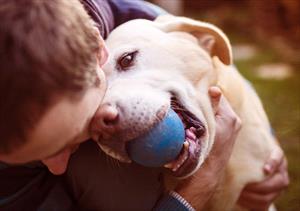A salivary mucocele, also known as a salivary gland mucocele or sialocele, is a swollen area associated with saliva (spit) leaking from a salivary gland into surrounding tissues. It can be caused by damage to either the salivary gland, which produces saliva, or the salivary duct, which is the passageway for saliva from the gland to the mouth.
What does a salivary mucocele look like?
Lab with ball leans on owner

Photo courtesy of Depositphotos
Dogs and cats have several salivary glands, but the most common place for a salivary mucocele is on or beneath the lower jaw or under the tongue. If the mucocele is on/under the jaw, a large swelling will be seen underneath the skin in that area. The swelling may be hard or squishy (almost like a water balloon). If the mucocele gets too large, the pet may have trouble eating, swallowing, or breathing. Mucoceles under the tongue can be more difficult to see but will appear as a tumor-like bulge or bubble on the floor of the mouth. This type of salivary mucocele is also referred to as a ranula. Mucoceles under the tongue may become so large that they can be seen next to the tongue or can prevent the mouth from closing properly. They can also cause trouble keeping food in the mouth and swallowing.
Uncommon places a salivary mucocele may be seen is on the cheek, where it’s seen as a swelling below the eye. The eye on the mucocele side of the face may appear larger than the eye on the healthy side. A bulge in the roof of the mouth may be seen as well.
How is a salivary mucocele diagnosed?
For the most part, salivary mucoceles are easy to diagnose. All that is usually needed is to remove some of the fluid and cells by suctioning them out with a needle and syringe, a process called aspirating. The salivary fluid is examined under a microscope to confirm the type of fluid and to look for bacteria in case the mucocele is infected.
What is the treatment for a mucocele?
Surgery is often needed to remove the diseased gland. If the mucocele is caused by a damaged duct, sometimes surgically creating a new opening in the duct can solve the problem without removing the gland. Fortunately, though, there are multiple salivary glands in the mouth so removing one will not have a major effect on saliva production. Once in a while, multiple surgeries are needed to ensure all diseased salivary tissue is removed.
Occasionally, the veterinarian will drain the mucocele to relieve some of the pressure on the neck and face. This is especially common when the mucocele is big enough to cause problems with eating, drinking, breathing, or swallowing. Almost all drained mucoceles refill with saliva again, so this is only a temporary solution. Antibiotics and anti-inflammatory medications may also be needed depending on if the mucocele is infected or if the pet has a lot of inflammation and pain.
Most pets who undergo surgery do extremely well and recover normally. Salivary mucoceles are uncommon. It is unlikely for them to recur after a successful surgery.